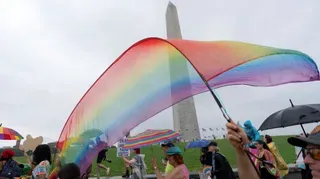August 17, 2013
Archivists Strive to Protect Gay Home Movies
Kilian Melloy READ TIME: 8 MIN.
The scenes in the cache of home movies at first glance are rather mundane, from a spirited 1957 New Year's Eve party and a poolside get-together to a summer vacation in the Cape Cod resort town of Provincetown, Massachusetts, circa the 1970s.
It is the people, mostly unknown men in their late 30s and 40s, captured on film who make the footage historic and worthy of preservation. Shown are intimate moments in the lives of a group of gay friends during a time when being out of the closet was career suicide for many people.
"I've been in the film business 46 years and I have never seen footage like this because people didn't allow these kinds of movies to be shot," said Ron Merk, a San Francisco-based film producer and director with the Metro Theatre Center Foundation. "There just wasn't a lot of gay home movies made."
The foundation has been saving and restoring old home movies of particular importance through its initiative the Preservation Project Partnerships with a support grant from Premiere Pictures International Inc. It has discovered a rare home movie of actor Spencer Tracy from 1931 and a color home movie of actor Stan Laurel.
It collaborated with the San Francisco Silent Film Festival, Monaco Film Laboratory, and Nordisk ShorCut digital restoration in Copenhagen to restore the Laurel film, which recently was screened at the Castro Theatre as part of the Kings Of Silent Comedy program.
"For the last year and a half we have been acquiring culturally and historically important home movies for a film preservation initiative we are working on," said Merk. "These are important documents in they capture the zeitgeist of a particular experience in a way most commercially produced movies do not. They are capsules of information on how we lived, what we ate, what we did."
Last year Merk, who is gay, saw a posting on eBay for a batch of old film reels that had belonged to David Eugene Bell, a famous home designer at Bloomingdale's whose clients included Carol Channing, Lucille Ball, and Joel Grey. In the 1970s he took up needlepoint and became a celebrated artist. He lived in Connecticut with his partner, Donald Cotter, and died in 2006 in his mid-80s.
According to Judith Gura's book New York Interior Design 1935-1985 Inventors of Tradition, Bell was born Eugene Weir Bell in Pennsylvania in 1921 and served in the U.S. Navy during World Word II.
Among the private moments Bell captured on film of himself and his friends dressing in drag, dancing with each other, and frolicking naked on the beach, there was also footage of Robert F. Kennedy marching in the New York City St. Patrick's Day Parade in the mid-1960s.
Warned that many of Bell's movies were being eaten away by mold, Merk nonetheless paid more than $1,000 for the 50 reels of 8mm and 16mm film. While some were in rather poor shape, with mold lifting the emulsion off the film, others were in better condition.
Estimating that the cost to properly preserve the collection would be $15,000 to $20,000, Merk turned to the crowdfunding site Indiegogo to try to raise the funds. It was the first time the foundation had asked the public to financially contribute to the preservation project.
It failed to attract donors, however, and Merk is now trying to find a single contributor who can fund the entire restoration work. He recently shared about 10 minutes of footage from Bell's home movies with the Bay Area Reporter in an attempt to draw attention to the project and raise awareness about the value in home movies, especially those depicting gay life decades ago.
"If we lose our history, we lose our future," said Merk. "This stuff is not going to last a hell of a lot longer in its present condition."
It is a message fellow gay filmmaker Stu Maddux is also trying to bring to the public's attention. He has been working on a documentary about gay home movies, titled Reel In The Closet, he hopes to premiere in early 2014.
"With this film I hope there is a realization for anyone who sees it - and it motivates not just LGBT people to look at their history but everybody - to look at what is in their closet," he said. "We hope to start a community discussion about saving home movies."
Reading about John Raines, a volunteer who has been digitizing old home movies in the archives of San Francisco's GLBT Historical Society so they are more accessible to researchers, documentarians, and members of the public, inspired Maddux to make his film.
Maddux, who lives in Novato, feels a personal affinity for the trove of celluloid material being safeguarded by various LGBT preservation groups around the country. He hopes viewers of his documentary will also become invested in saving and preserving the archived films for future generations.
"This is to recognize it is historic. Their day-to-day lives, their picnics, their camping trips, their family reunions, their gatherings is all historic material," said Maddux, who plans to launch his own crowdfunding campaign next month to raise the $35,000 he needs to complete his film. "It is not the events, it is the day-to-day life depicted on screen; that is what is so valuable. People don't think they are part of history, but really, they are."
The oldest films in the local GLBT Historical Society's archives date back to the late 1930s. Taken by filmmaker Harold O'Neal, the movies depict life in southern California and continue through the 1980s.
The footage, according to the collection description, includes female impersonators performing at the Beige Room in San Francisco, gay men socializing in the 1940s including drag and other camp images, and gay freedom day parades from 1978 to 1980. Directors Jason Plourde and Sean David West turned some of the film into their 2004 documentary Harold's Home Movies.
Other archived footage comes from photographer Henri Leleu, who documented the leather community, motorcycle runs, tricycle races, drag events, demonstrations, and parades throughout the 1960s and 1970s, noted Marjorie Bryer, Ph.D., the society's managing archivist.
"We do have a strong collection," she said.
Bryer added there is also "very brief footage" of legendary drag queen Jose Sarria at the Black Cat, circa 1963, and some 8mm films from the late 1960s taken by an unknown filmmaker that feature footage of gay bars in the Tenderloin and Polk Street neighborhoods.
"It is something we love to have here and share it with filmmakers and television show producers," said Bryer, adding that they pay to use the footage on a sliding scale. "It really brings films to life to have historic footage."
Yet the society has not been able to fully catalogue its holdings, which not only includes 8mm and 16mm films but also VHS videotapes.
"One thing we would love to get is funding to do a survey to be able to document exactly how much footage we have," said Bryer. "It is hard for me to say with the video collection what we have."
Some of the film is too fragile to handle in-house, noted Bryer, or requires special equipment to view. In order to digitize those reels, the society would have to hire an outside film preservationist.
"It is expensive to do it. We need help from the community to donate funds or we need grants," said Bryer, adding that sometimes filmmakers interested in certain footage housed in the archives will pay to have it digitized. "It is not out of neglect, it is a sheer question of resources."
Nonetheless, Bryer said the society welcomes donations of home videos, especially if they are Bay Area-based. She will also direct donors to other groups collecting such material with more resources for digitizing the film.
"If we could get a concentrated bulk of them donated to the archives and generate a groundswell of people coming forward to give us film, we could use that to leverage getting grant money," suggested Bryer. "I think it is always valuable to see representation of your life on film. People who see any of O'Neal's films are really delighted to see footage of people like themselves being able to be free and themselves 50 and 60 years ago."
Maddux urged people to check their basements and attics for any old home movies stored away there and find a better place to protect the footage so that it will be preserved for posterity.
"It gives me butterflies in my stomach to think the pre-Stonewall period is getting thrown away. People are dying and their estates are getting cleared out by people who don't know what they have, or in some cases, don't want their loved one remembered as an LGBT person," said Maddux. "We have so limited information already, it is fading away like that photograph in the film that fades away in the attic. We are not going to have it in another 20 years."
Eventually the Bell collection, the first Merk has acquired that features LGBT content, will be housed in the Academy of Motion Picture Arts and Sciences' Academy Film Archive, which is amassing a library of home movies featuring Hollywood stars to ordinary people. The footage is made available to scholars for study and can be licensed by filmmakers for commercial use.
The hope, said Merk, is that the home movies "will be self-generating income for other film preservation work."
Lynne Kirste, the special collections curator at the Academy Film Archive, stressed that no matter what condition the film may be in, people should not throw it out.
"People will make a digital copy and throw the film away when we can make a way better copy. We will do color correction and speed change," said Kirste, an out lesbian who serves as the home movie curator for the Los Angeles-based archive. "We can really pull a lot out of a film. When we only have a DVD to go by, though, there is a lot less we can do with it."
As for what the Academy's archives collect, Kirste said she is interested not only in home movies made by screen legends but also those featuring LGBT people and people of various ethnicities who were rarely seen in classic mainstream films.
"The strength of home movies, particularly when we are talking about people or groups of people that haven't been well-represented in mainstream films, is that home movies are where you can find a lot of documentation of the lives and stories of these people," she said. "These are their stories shot by their own cameras."
The footage counters the stereotyped portrayals of people of color and homosexuals in the early days of movies, added Kirste, who regularly holds screenings of the home movies in the archive's collection to interest the public in the material.
"We don't want to have things sitting on shelves that no one is looking at. We really want people to see them and see that this is very important to our mission," said Kirste, who has begun posting some clips to YouTube as one way to promote the archived films. "It is really important that we get our home movies into archives and get them preserved. I am really committed to that personally, and it is something the Academy archives takes seriously."
See the online version of this story on ebar.com for a short video about Merk's preservation work. More information about the project can also be found at http://www.MetroCenterFoundation.org.
Anyone interested in donating to the project should email [email protected] or call 415-441-1325. To learn more about Maddux's film, visit http://stumaddux.com/Reel_In_The_Closet_About.html.
Kilian Melloy serves as EDGE Media Network's Associate Arts Editor and Staff Contributor. His professional memberships include the National Lesbian & Gay Journalists Association, the Boston Online Film Critics Association, The Gay and Lesbian Entertainment Critics Association, and the Boston Theater Critics Association's Elliot Norton Awards Committee.





